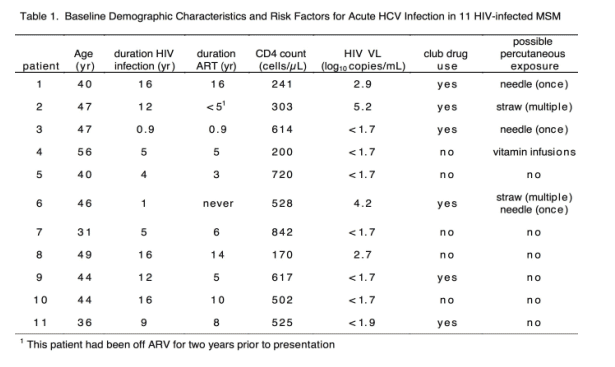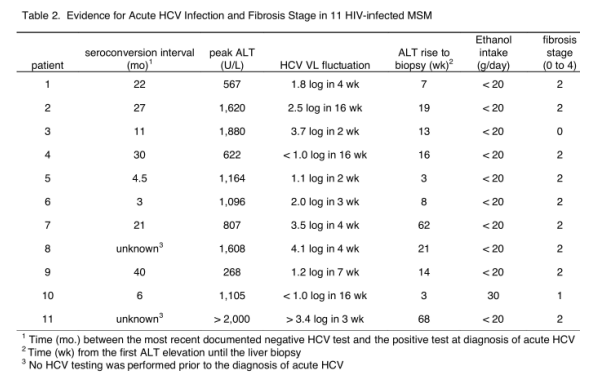 |
 |
 |
| |
Liver Fibrosis in an Outbreak of Acute HCV in HIV-infected MSM; accelerated HCV progression if HIV is contracted before HCV
|
| |
| |
Reported by Jules Levin, CROI Feb 3-6, Boston
Daniel S. Fierer,1 Alison J. Uriel,1 Damaris C. Carriero,1 Arielle Klepper,1 Douglas T. Dieterich,1 Michael P. Mullen,1 Swan N. Thung,2 M. Isabel Fiel,2 and Andrea D. Branch1
Departments of 1Medicine and 2Pathology, Mount Sinai School of Medicine, New York
From Jules: some have questioned this research suggesting perhaps other risk factors may have been responsible for this finding, including antiretrovirals, illicit drugs, alcohol, steatohepatitis, underlying chronic HBV or HCV.. The study authors response is that they have considered these alternative possible explanations, many of which are addressed in the poster and are confident of their findings.
ABSTRACT
Background: Hepatitis C virus (HCV) is an emerging infection among HIV-infected men who have sex with men (MSM). These men are unusual in that they acquired HCV after they acquired HIV, whereas HCV is typically acquired first. Because individuals who are immunocompromised at the time they acquire HCV often progress to end stage liver disease in as few as three years, these HIV-infected men with acute HCV are potentially at high risk for rapidly progressive liver injury.
Methods: We performed a prospective cohort study of HIV-infected MSM with acute HCV infection to evaluate liver histology and risk factors for acquisition of HCV. Acute HCV infection was diagnosed using a combination of three criteria: HCV antibody seroconversion, ALT elevation to > 5-fold over the upper limit of normal, and wide fluctuation in HCV viral load, a hallmark of the acute phase of HCV infection.
Results: Eleven patients underwent liver biopsy, nine within 4 _ months of the detection of ALT elevation, and two within 16 months. Despite the short duration of HCV infection, nine (82%) of 11 patients had stage 2 fibrosis (Scheuer, scale 0 to 4) and one had stage 1 fibrosis. The mean FPR in these 11 patients was 4.3 ± 2.7 units per year. No cause of liver damage other than acute HCV infection was identified. In the analysis of risk factors for HCV acquisition, only four patients reported even a single episode of IDU. In contrast, non-IDU and high risk sexual behavior were common: seven reported "club" drug use, including methamphetamine, and ten reported unprotected anal intercourse with multiple partners.
Conclusions: Acute HCV infection of MSM with underlying HIV infection resulted in early and rapid progression of liver fibrosis, with FPR rates far in excess of other settings of HCV infection. Some of these HIV-infected men with acute HCV did not appear to have percutaneous exposures and may have become HCV-infected via sexual activity. More intensive prevention and screening strategies for acute HCV in MSM are needed. In addition, further research is needed to identify the disease processes leading to this highly accelerated liver injury.
BACKGROUND
Immunosuppression accelerates fibrosis progression in HCV-infected patients. The magnitude of the acceleration is relatively modest if immunosuppression occurs after the chronic phase of HCV infection has been established. Thus, while the fibrosis progression rate (FPR) of patients with chronic HCV infection and end stage renal disease is about 0.11 fibrosis units/year, if these patients undergo kidney transplantation and begin receiving immunosuppressive drugs, the FPR increases to about 0.14 units/year (Figure 1). Injecting drug users (IDU), who typically acquire HCV before HIV, provide another example. Classic studies indicate that the FPR of patients with chronic HCV mono-infection is about 0.11 units/year and that the FPR of patients with chronic HIV/HCV co-infection is less than 2-fold greater, about 0.15 units/year. The majority of HIV/HCV co-infected IDU are not expected to develop cirrhosis (stage 4 fibrosis) for twenty years, or more.
In contrast, patients who acquire HCV when they already have defects in cellular immunity are reported to progress to cirrhosis, end stage liver disease, and death in as few as three years. This dire outcome has been observed in transplant patients, patients with hematological disorders and immunodeficiencies, and patients with pre-existing HIV-infection. Fortunately, HCV infection of immunocompromised patients has been rare, especially since the advent of blood screening tests. Recently, however, outbreaks of acute HCV infection in HIV-infected men-who-have-sex-with-men (MSM) have been reported in Europe and the United States. The rapid fibrosis progression of other groups of immunocompromised patients with newly-acquired HCV suggests that these men may be at a high risk for greatly accelerated liver damage. To explore this possibility and to determine risk factors for HCV transmission, we performed a prospective study of HIV-infected MSM who recently acquired HCV infection.
MATERIALS & METHODS
Study population
We enrolled 11 HIV-infected MSM with acute HCV infection who underwent liver biopsy during the early phase of HCV infection into a prospective study of acute HCV infection. Written informed consent was obtained from all patients.
Liver biopsy
Percutaneous liver biopsies were performed using 18 gauge x 100 mm Jamshidi Menghini needles (Allegiance Healthcare Corp., McGaw Park, Ill.). Specimens were formalin fixed, paraffin embedded, and treated with hematoxylin-eosin and trichrome stains. The Scheuer criteria for chronic HCV infection were applied, although the patients were in the acute phase of HCV infection. Immunostains for HBsAg and HBcAg were performed.
Fibrosis progression rate
FPRs were determined by dividing the fibrosis stage in units (according to the Scheuer system) by the interval between the estimated date of infection and the date of the biopsy (in years). Infection was estimated to have occurred eight weeks prior to the first new ALT elevation.
Clinical data and laboratory testing
All patients underwent serological testing for hepatitis A virus (HAV) IgM, and hepatitis B virus (HBV) surface antigen (HBsAg), e antigen, core antibody (HBcAb), surface antibody, e antibody; and HBV DNA testing.
· HCV antibody test was a 3rd generation HCV EIA version 2.0 (Abbott Laboratories, North Chicago, IL
· HCV viral load (VL) test was HCV COBAS AMPLICOR version 2.0 (Roche Diagnostics, Branchburg, NJ; cutoff, 2.8 log10 IU/mL)
· HCV was genotyped by INNO-LiPAssay (Bayer Diagnostics, Berkeley, CA)
· HBV DNA test was real-time PCR (Quest Diagnostics Nichols Institute, Chantilly, VA; cutoff, 100 IU/mL)
· HIV VL test was AMPLICOR version 1.5 (Roche Diagnostics; cutoff, 1.7 log10 copies/mL)
RESULTS
Acute HCV infection diagnosis (Table 1)
Acute HCV infection is defined as the first six months of an HCV infection.
Because no single test result provides a definitive diagnosis of acute HCV infection, we considered three factors in combination:
1. seroconversion to HCV antibody positivity
2. marked elevations in serum ALT levels (> 5-fold elevation above upper limit of normal); and
3. wide fluctuations in HCV viral load (> 1 log within 16 weeks)
The latter two are considered to be hallmarks of acute HCV infection and are rare during chronic infection.
· All patients had negative evaluations for active HAV or HBV infection.
· No evidence for other etiologies of new hepatitis was found.
Risk factors for acute HCV infection (Table 1)
· ten patients had recently engaged in unprotected receptive anal intercourse, some with many partners
· none had an ulcerative sexually transmitted infection within the prior year
· three reported a single recent episode of injecting methamphetamine; one remembered sharing the injection equipment, but the other two had no recollection of sharing injection equipment
· three shared paraphernalia used for snorting drugs on multiple occasions with other MSM; one had a possible percutaneous exposure, as he received multiple intravenous infusions of vitamins from a non-medical practitioner
· five men denied any parenteral risk factors or club drug
CONCLUSIONS
Acute HCV infection of MSM with underlying HIV infection resulted in early and rapid progression of liver fibrosis. Many of these HIV-infected men with acute HCV used non-injection drugs and had unprotected sex with multiple partners; some appear to have become HCV-infected via sexual activity. As most acute HCV infections are asymptomatic, more intensive screening of MSM for acute HCV is warranted. Further research is needed to identify the disease processes leading to the liver


Liver histopathology
· percutaneous liver biopsy was performed three to 21 weeks after the onset of hepatitis (first new ALT elevation) in nine patients, and 14 and 16 months after the onset in two additional patients
· all patients underwent biopsy prior to initiation of IFN/RBV except patient 3, who had received less than one week of therapy
· the Scheuer system was applied to determine the fibrosis stage (scale 0-4)
· nine biopsies had stage 2 fibrosis; one had stage 1 fibrosis; and one had stage 0 fibrosis (Table 2)
· the biopsies also showed portal inflammation, interface hepatitis, and necroinflammatory changes in the lobules
· immunostains for HBsAg and HBcAg were negative in all patients
a representative biopsy is shown in Figure


|
| |
|
 |
 |
|
|